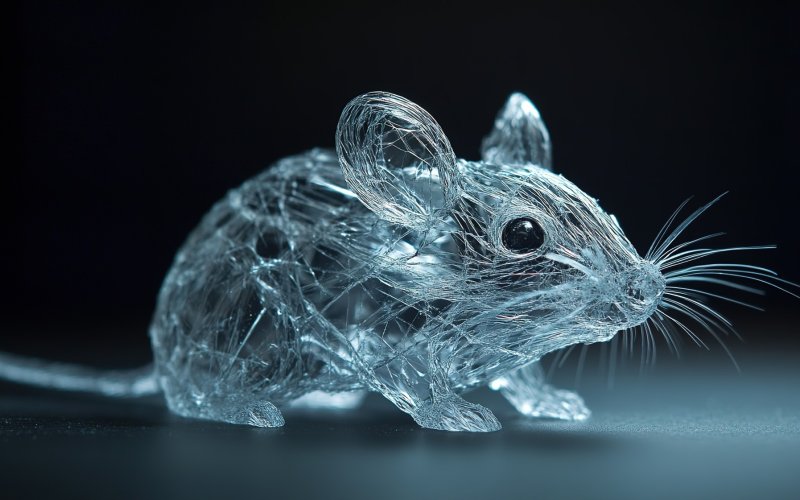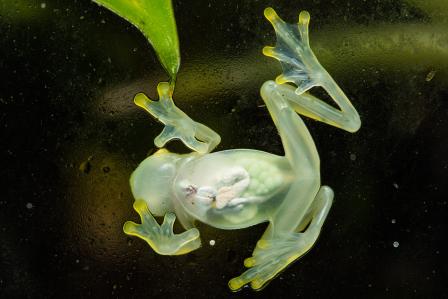Human beings have always longed to be invisible. Fables and myths are full of potions, incantations and cloaks of invisibility. H. G. Wells attempted to grasp the idea of invisibility a little more scientifically in his novel The Invisible Man. In it, the hero invents a substance that makes all the cells of his body transparent.
Total invisibility is interesting for literary fiction; partial invisibility would be amazing for science. Biologists are eager to find out what's going on inside the organisms they study. They’d like to see neurons firing, hearts beating, muscle fibres contracting, or intestinal peristalsis working. But to see inside a living creature, they have to cut it open. A transparent animal could be studied completely non-invasively under normal conditions.
The opacity of the skin is due to its optical properties. Light falling on an object is partly absorbed and partly reflected by it. The reflected rays are then perceived as the colour of the object. A red ball is therefore not red — it just reflects red rays and absorbs rays of other colours. If the arrangement of molecules in the object is such that the ray can pass through without significant change, we perceive it as transparent. If the ray inside the object is reflecting in all directions, it cannot reach the other side and we perceive the object as opaque.
A complex object like skin is made up of many substances. There’s water, fats, proteins, hemoglobin, and each molecule has a different refractive index. When light passes into a different environment, it changes its direction of propagation. It is different when it passes through water, and different when it passes through fat. As a result, the skin looks opaque and we can’t see our internal organs.
So-called glass frog, member of the amphibian family Centrolenidae, with partially translucent body. (Source: stock.adobe.com)
There are animals in which transparency has evolved as a protection against predators. Most often these are aquatic animals, shrimp, jellyfish or fish. There is also a group of tree frogs called glass frogs which have skin and muscles so transparent that their internal organs can be seen. The frogs achieve transparency by the absence of colour pigments in their skin and by storing red blood cells in the liver during rest. Rather than being perfectly transparent, they are greenish translucent. Aquatic animals achieve better transparency. They have a lot of water in their bodies that has the same refractive index as the water around them, and as a result, more rays propagate right through their bodies.
Achieving transparency requires two things. Firstly, removing pigments, i.e. substances in the skin that absorb or reflect light, and secondly, getting all the substances that make up the skin to have the same refractive index. Individuals without pigment are known to nature. They are albinos. However, they are not transparent, but white to pinkish. The pink hue is due to the blood vessels, while the white colour of the fur is due to the structure of the hair, which reflects light in many directions instead of letting it through smoothly.
The first attempts to create a transparent animal so that scientists could see its neurons highlighted by phosphorescent dye involved removing all the lipids from the body and replacing them with transparent hydrogel. Its refractive index was close to that of water. A method called CLARITY involves a series of drastic chemical treatments that cannot be applied to a living creature. In addition, the process takes several days. The method is therefore most often used only on small biological samples.
Researchers at Stanford University decided to go in a different way. Rather than changing the tissue to make its refractive index closer to that of water or air, they decided to try to change the refractive index of water. A common yellow food dye known as tartrazine was enough to make the skin transparent for now, only in mice. When they rubbed it on the shaved skin of the mouse's abdomen, it became transparent. They could see its heartbeat and intestinal peristalsis. By rubbing it on other parts, they could observe the activity of the brain or the leg muscles.
The trick was to change the refractive index. Skin painted with yellow-orange dye absorbs mostly the blue part of the spectrum. The skin becomes reddish, but more importantly, in red, the refractive index of water approaches that of lipids. This significantly reduces light scattering in the skin and shows the organs underneath. This clever trick gave scientists the ability to study the internal organs of the mouse without having to cut into it in any way. The process was reversible. Once the mouse was washed, its skin became opaque again.
Although tartrazine is a commonly available dye used in the food industry, scientists strongly discourage testing its effects on yourself. Developing a safe transparency cream, however, could wonderfully expand diagnostic methods and save many patients from invasive procedures.
Want to ask something?
Send us an e-mail with the subject “Physics mysteries” to the address:
We can't wait to tackle your interesting questions!






